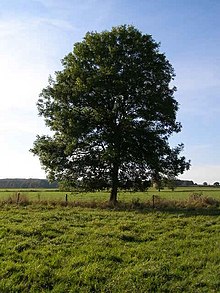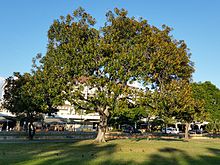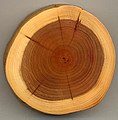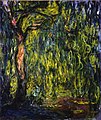Portal:Trees
The Trees Portal

In botany, a tree is a perennial plant with an elongated stem, or trunk, usually supporting branches and leaves. In some usages, the definition of a tree may be narrower, including only woody plants with secondary growth, plants that are usable as lumber or plants above a specified height. In wider definitions, the taller palms, tree ferns, bananas, and bamboos are also trees.
Trees are not a monophyletic taxonomic group but consist of a wide variety of plant species that have independently evolved a trunk and branches as a way to tower above other plants to compete for sunlight. The majority of tree species are angiosperms or hardwoods; of the rest, many are gymnosperms or softwoods. Trees tend to be long-lived, some reaching several thousand years old. Trees have been in existence for 370 million years. It is estimated that there are around three trillion mature trees in the world.
A tree typically has many secondary branches supported clear of the ground by the trunk, which typically contains woody tissue for strength, and vascular tissue to carry materials from one part of the tree to another. For most trees it is surrounded by a layer of bark which serves as a protective barrier. Below the ground, the roots branch and spread out widely; they serve to anchor the tree and extract moisture and nutrients from the soil. Above ground, the branches divide into smaller branches and shoots. The shoots typically bear leaves, which capture light energy and convert it into sugars by photosynthesis, providing the food for the tree's growth and development.
Trees usually reproduce using seeds. Flowers and fruit may be present, but some trees, such as conifers, instead have pollen cones and seed cones. Palms, bananas, and bamboos also produce seeds, but tree ferns produce spores instead.
Trees play a significant role in reducing erosion and moderating the climate. They remove carbon dioxide from the atmosphere and store large quantities of carbon in their tissues. Trees and forests provide a habitat for many species of animals and plants. Tropical rainforests are among the most biodiverse habitats in the world. Trees provide shade and shelter, timber for construction, fuel for cooking and heating, and fruit for food as well as having many other uses. In much of the world, forests are shrinking as trees are cleared to increase the amount of land available for agriculture. Because of their longevity and usefulness, trees have always been revered, with sacred groves in various cultures, and they play a role in many of the world's mythologies. (Full article...)

Ficus rubiginosa, the rusty fig or Port Jackson fig (damun in the Dharug language), is a species of flowering plant native to eastern Australia in the genus Ficus. Beginning as a seedling that grows on other plants (hemiepiphyte) or rocks (lithophyte), F. rubiginosa matures into a tree 30 m (100 ft) high and nearly as wide with a yellow-brown buttressed trunk. The leaves are oval and glossy green and measure from 4 to 19.3 cm (1+1⁄2–7+1⁄2 in) long and 1.25 to 13.2 cm (1⁄2–5+1⁄4 in) wide.
The fruits are small, round, and yellow, and can ripen and turn red at any time of year, peaking in spring and summer. Like all figs, the fruit is in the form of a syconium, an inverted inflorescence with the flowers lining an internal cavity. F. rubiginosa is exclusively pollinated by the fig wasp species Pleistodontes imperialis, which may comprise four cryptospecies. The syconia are also home to another fourteen species of wasp, some of which induce galls while others parasitise the pollinator wasps and at least two species of nematode. Many species of bird, including pigeons, parrots, and various passerines, eat the fruit. Ranging along the Australian east coast from Queensland to Bega in southern New South Wales (including the Port Jackson area, leading to its alternative name), F. rubiginosa grows in rainforest margins and rocky outcrops. It is used as a shade tree in parks and public spaces, and when potted is well-suited for use as an indoor plant or in bonsai. (Full article...)Did you know? -
- ... that Gregory's tree (pictured), near Timber Creek in Australia's Northern Territory, bears inscriptions by 19th-century explorers and is registered as both a heritage place and an Aboriginal sacred site?
- ... that the Balderschwang Yew is possibly the oldest tree in Germany?
- ... that black truffles suppress plant growth around their host tree, creating an area that looks burned?
- ... that root extracts from the tree species Pycnanthus angolensis can be used to treat parasitic infections, such as schistosomiasis?
- ... that the lime trees of Duncliffe Wood are reputedly among the oldest living things in the county of Dorset?
- ... that trees of the New Guinea genus Finschia have stilt roots coming off the trunk up to 1.8 m (6 ft) off the ground?
- ... that in the early 1980s, a team of surveyors discovered the World War II-era Avro Anson Memorial near Clackline, Western Australia, which had been overgrown by shrubs and trees?
Selected article -

Krummholz (German: krumm, "crooked, bent, twisted" and Holz, "wood") — also called knieholz ("knee timber") — is a type of stunted, deformed vegetation encountered in the subarctic and subalpine tree line landscapes, shaped by continual exposure to fierce, freezing winds. Under these conditions, trees can only survive where they are sheltered by rock formations or snow cover. As the lower portion of these trees continues to grow, the coverage becomes extremely dense near the ground. In Newfoundland and Labrador, the formation is known as tuckamore. Krummholz trees are also found on beaches such as the Oregon coast, where trees can become much taller than their subalpine cousins.
The labeling of diverse sets of tree species in different ecological contexts may be problematic. The ecological requirements of krummholz trees in the Alps, for example, are different from those in the Rockies. The terms scrub or shrubland may be more appropriate for some communities with krummholz trees. (Full article...)General images
Selected lists
Subcategories
Related portals
Associated Wikimedia
The following Wikimedia Foundation sister projects provide more on this subject:
-
Commons
Free media repository -
Wikibooks
Free textbooks and manuals -
Wikidata
Free knowledge base -
Wikinews
Free-content news -
Wikiquote
Collection of quotations -
Wikisource
Free-content library -
Wikispecies
Directory of species -
Wikiversity
Free learning tools -
Wiktionary
Dictionary and thesaurus














































































